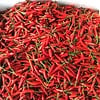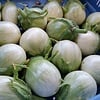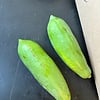Krapao Leaf / holy basil leaves
Pad Ka Prao is one the most popular street food in Thailand. I have not met anyone that did not know this spicy and delicious dish. The key to make this menu lies in fresh holy basil and fire cracker chilli with these two combinations will guaranteed you Read more
Description/Taste
Holy, or Sacred basil, is a stiff, leafy, perennial herb. The plant can reach up to 18 inches in height, and develops small pink, fragrant blossoms when mature. With thicker stems, ranging in color from green to a dark purple, Holy basil has a bushy appearance and can grow quite large. Holy basil’s narrow, oval leaves range from a light green to deep purple color and are very aromatic. The taste does vary between types, however, it is often likened to cloves (anise) or licorice with a hint of mint and a bit of peppery spice. The pungent pink flowers are also edible.
Seasons/Availability
Holy basil is available during the summer months.
Current Facts
Holy basil is botanically known as Ocimum gratissimum, Ocimum sanctum and more recently, Ocimum tenuiflorum. There are several varieties of Holy basil, most often broken into two groups – dark ‘krishna’ and light ‘rama’. Holy basil is a cousin of the more common sweet basil. Called Tulsi or Sacred basil in its native India and used for religious purposes, Holy basil is revered and is not typically used for cooking. In Thailand, however, Holy basil is known as ‘Bai gkaprow’ and is commonly found in Thai cuisine.
Nutritional Value
Holy basil contains a rich supply of antioxidants. The essential oils in Holy basil contain eugenol, which has anti-inflammatory properties and is being studied for its ability to inhibit cancer cell growth. Research has also been done on Holy basil around its ability to help protect stomach lining from the damages of aspirin. The ancient herb also contains compounds that aid in digestion and nutrient absorption in the digestive tract, making it a good addition to the diets of those with chronic digestive issues.
Applications
Holy basil is most commonly used to make tea, however, in Thailand, it is a very popular culinary ingredient. Holy basil is an important ingredient in one of the more famous Thai street dishes, chicken with Holy basil or ‘gai pad grapow’. In many Thai stir fry dishes, Holy basil is used as an aromatic with garlic, fish sauce and chilies to impart flavor into meat, fish, or chicken. Holy basil is best used fresh, as its leaves cannot maintain their aroma after a few days in the refrigerator.
Ethnic/Cultural Info
Holy basil is very much a part of the culture and religion throughout India. Used by Hindu monks and Ayurvedic practitioners for centuries, Holy basil is called “Queen of the Herbs.” Considered sacred to the Hindu god Vishnu, Holy basil is used in morning prayers to ensure good health, spiritualism, and the well-being of one’s family. Ayurvedic medicine considers Holy basil an adaptogenic herb, with the ability to increase the body’s resistance to stress and disease.
Geography/History
Holy basil is native to India, where it has been a part of the culture since ancient times. Wild Holy basil, O. tenuiflorum, grows wild in parts of Asia and Africa, and different varieties are cultivated around the world. It grows as a perennial in tropical and subtropical environments and can be grown as an annual from seed or cuttings in other regions. Holy basil is commonly found in the lowlands of India, Malaysia, and other parts of Indonesia and China.
Herb or subshrub to 1 m high, much-branched, with a pungent aromatic odour, the branchlets and new growth pubescent with soft white hairs. Leaves with blades elliptic to elliptic-oblong, 3–6 cm long, 1–2.5 cm wide, cuneate to attenuate at base, obtuse to acute at apex, entire to remotely serrate at margins, pubescent on both surfaces but especially on the nerves beneath; petioles 1–2.5 cm long, softly pubescent. Flowers terminal, slender racemes or panicles 4–12 cm long, 1–1.5 cm wide, the bracteoles 2–3 mm long, ovate, acuminate, ciliate; flowers in verticils, on pedicels 2–4.5 mm long; calyx c 2.5 mm long at anthesis, in fruit up to 5 mm long, glabrous within, the upper lip suborbicular, reflexed, short-apiculate, the lower lip longer than the upper lip, the teeth 4, lanceolate; corolla pale pink, pale lavender or white, to 4 mm long; filaments of stamens exserted, slender, the upper pair of each with a small, bearded basal appendage. Fruit with nutlets purple-green to brown, broadly ellipsoid, 0.8–1.2 mm long, smooth to minutely pitted, swelling in water



 vegetables
vegetables
 fruit
fruit
 chilli
chilli
 eggplant thai
eggplant thai
 NEW project - GREEN PAPAYA THAI.
NEW project - GREEN PAPAYA THAI.


